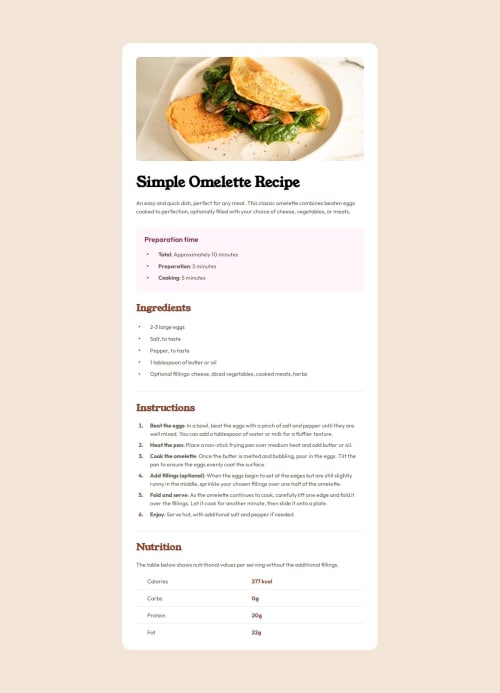Recipe Page built using CSS Architecture

Solution retrospective
-
Better understanding different HTML elements.
-
Studing the aside tag, found that it is used as a call-out box Aside definition from web.dev.
-
Always thought that tables were old school, but I understand now that tables are suitable for displaying tabular data in a structured and understandable manner, as it is in the Nutrition section.
-
Learnt how to change color of the bullet markers.
-
Learnt this CSS property
list-style-position: inside;to deal with inline bullet lists. Not the case in this project. -
Explored how bullet lists are rendered from ul and ol tags. See this content Custom bullets with CSS ::marker.
-
I wouldn't add a container encapsulating header, main and footer. I don't like this, but since we have backgrounds all over the project and we have to add margins, paddings and stuff to the global layout. To solve this, I added a pseudo-element ::before to the body, so now I have two backgrounds placed correctly.
-
Changing the default behaviour of li from
display: list-itemtodisplay: flexwill cause the loss of appearance of markers. You will have to manage it manually. -
To get better responsiveness and attend to the design, the li tags must be
display: flex;andalign-items: center.
Not sure. If you find anything please feel free to help. Thank you for your help!
Please log in to post a comment
Log in with GitHubCommunity feedback
- @mikov144
Hi! Great work! I don't have too much to add, but I noticed that in some places you have 2 spaces before the line, and in some it's 4. Wouldn't it be better to keep everything on 2 spaces, so the code is not going to get so stretched? Then again, good job!
Marked as helpful
Join our Discord community
Join thousands of Frontend Mentor community members taking the challenges, sharing resources, helping each other, and chatting about all things front-end!
Join our Discord